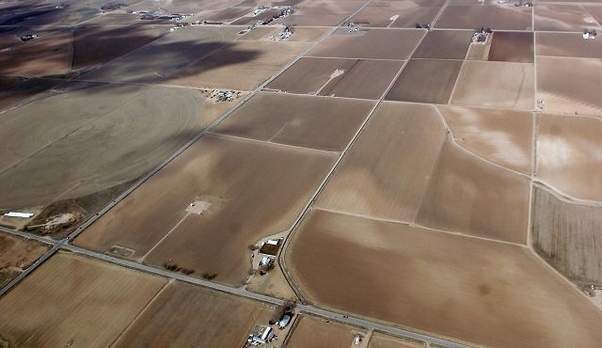Despite ongoing challenges in commodity markets and uncertain farm profitability, agricultural land values have remained remarkably stable through mid-2025. File photo
Land-RFP-072125
OMAHA, Neb. — Despite ongoing challenges in commodity markets and uncertain farm profitability, agricultural land values have remained remarkably stable through mid-2025, according to Farmers National Company. This resilience is mainly driven by the basic economic principle of supply and demand; there are simply more motivated buyers than willing sellers.
While producers remain the main buyers of ag land, interest from individual and institutional investors cannot be ignored, Farmers National Company noted. As land values stabilize after reaching peaks within the past five years, investors are increasingly attracted by both annual returns and long-term appreciation. According to Farm Credit Services of America, benchmark Midwest farmland values have increased 56.9% over the past five years and 38.3% over the past decade, reinforcing land’s appeal as a long-term asset.
Inventory remains limited, with listings down 20–25 percent from the peak in 2020–2021. Many long-term landowners are choosing to hold onto their properties, recognizing the stability and value appreciation land offers compared to more volatile investments.
According to Paul Schadegg, senior vice president of real estate at Farmers National Company, farm profitability will be a key factor affecting land values in the future.
“The USDA forecasts 2025 net farm income to be the lowest since 2020. This will likely influence producer purchasing power and investor returns, especially as input costs, commodity prices and interest rates fluctuate,” said Schadegg. “While balance sheets generally remain strong, any negative movements in the ag economy could quickly impact the land market.”
Geopolitical developments also influence the market. Trade policies, tariffs and global unrest create uncertainty, impacting both domestic and international markets. While renegotiated trade agreements may present future opportunities, current tariffs could decrease demand for U.S. agricultural exports as other countries expand their production and infrastructure.
Looking into the second half of 2025, those with solid financial positions — both producers and investors — will be best equipped to pursue land purchase opportunities. During periods of volatility, Farmers National Company sees strong demand for real estate and management services as landowners seek answers in today’s market.
Farmers National Company has successfully marketed more than $450 million in land value in the first half of 2025.
“We have had a strong start to the year and will continue to adapt to the global elements that impact the land value market,” Schadegg said.
South Central Region: Kansas, Eastern Colorado, and Western Missouri — Steve Morgan, area sales manager
High-quality farmland values from Colorado through Kansas to Missouri remain steady despite regional differences in rainfall and soil types. Since July 2024, some tracts have sold for more than 5% above market in competitive auctions, while others have dipped slightly below last year’s prices.
Average prices per acre sit at $5,800 in Kansas, $7,500 in Missouri and $3,500 in Oklahoma. Notable recent sales include a $2.89 million transaction for 150.8 acres in Brown County, Kansas.
As the 2025 season unfolds, weather and irrigation access will be key factors in crop performance, particularly in western parts of Missouri and Kansas. Local land experts continue to track production and pricing trends across the region.
Western Region: Western Nebraska, Northwest Kansas and Northeastern Colorado — Cole Nickerson, area sales manager
Pressure on net farm income in 2025 continues to keep land values at or below the peaks seen in recent years. High interest rates and lower commodity prices are the main reasons farmers are hesitant to invest in additional farmland. These financial pressures have narrowed margins for many producers, resulting in more cautious land investment behavior.
As a result, we are seeing a decline in public land listings throughout the territory. Additionally, there has been a slight shift from public auction to traditional listings as sellers aim to protect their investment value. High-quality land remains a highly sought-after commodity, both at auction and through listings. Strong interest in productive irrigated cropland with good access, desirable soils and ample water has kept those values high. Farms with less productive soils, poor access or terrain issues have experienced the greatest decline in value.
Pasture and hay meadow land have been the bright spot in the local land market. All-time highs in feeder cattle prices, along with elevated cash rental rates, have supported strong demand for grazing land. Hardland pastures with quality fences and excellent access are attracting the most interest from buyers. Although higher cattle prices have brought positivity to the local land market, it hasn’t been enough to offset the broader decline in average land value across the region.
West-Central Region: Eastern Nebraska and Western Iowa — Chanda Scheuring, area sales manager
Land values in Eastern Nebraska and Western Iowa have stayed fairly steady over the past couple of years, despite challenges from lower commodity prices and rising input costs. But the big question on everyone’s mind is whether this market can be sustained.
As the agricultural economy has less readily available cash than in previous years, some farmers are or already have started to feel pressure from their financial lenders. Discussions about tightening budgets and even selling a quarter of their land have been topics some local loan officers have suggested to a few of their clients.
Still, some top producers want to, and have the financial ability to, expand their operations over the coming year by buying more farmland. But that pool of buyers is shrinking.
With the changing market, it’s important to partner with a local real estate professional to not only understand the current value of your farm property but also the best way to market it in a shifting economy.
Despite ongoing challenges in commodity markets and uncertain farm profitability, agricultural land values have remained remarkably stable through mid-2025. File photoLand-RFP-072125
More Like This, Tap A Topic news

